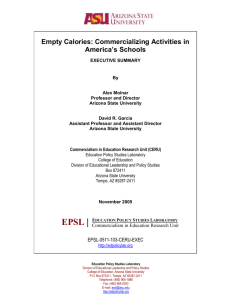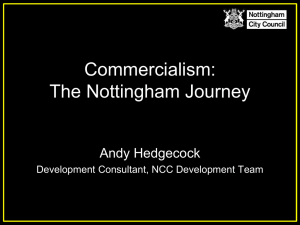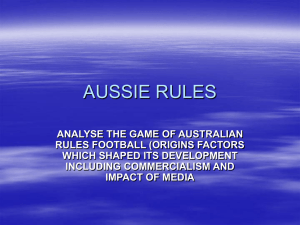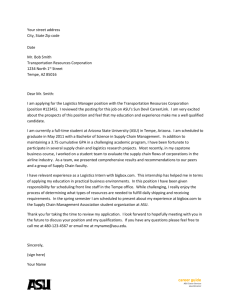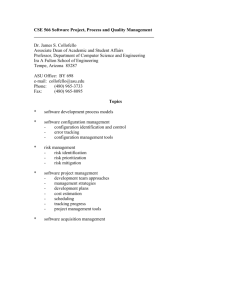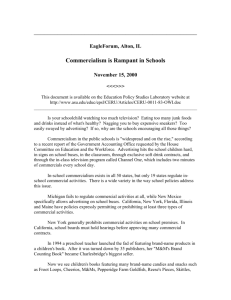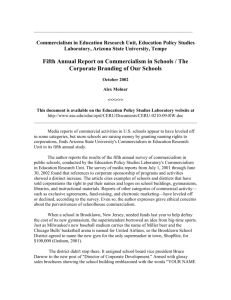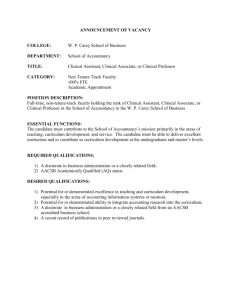Commercializing Schools: A Threat to Our Children's Health
advertisement
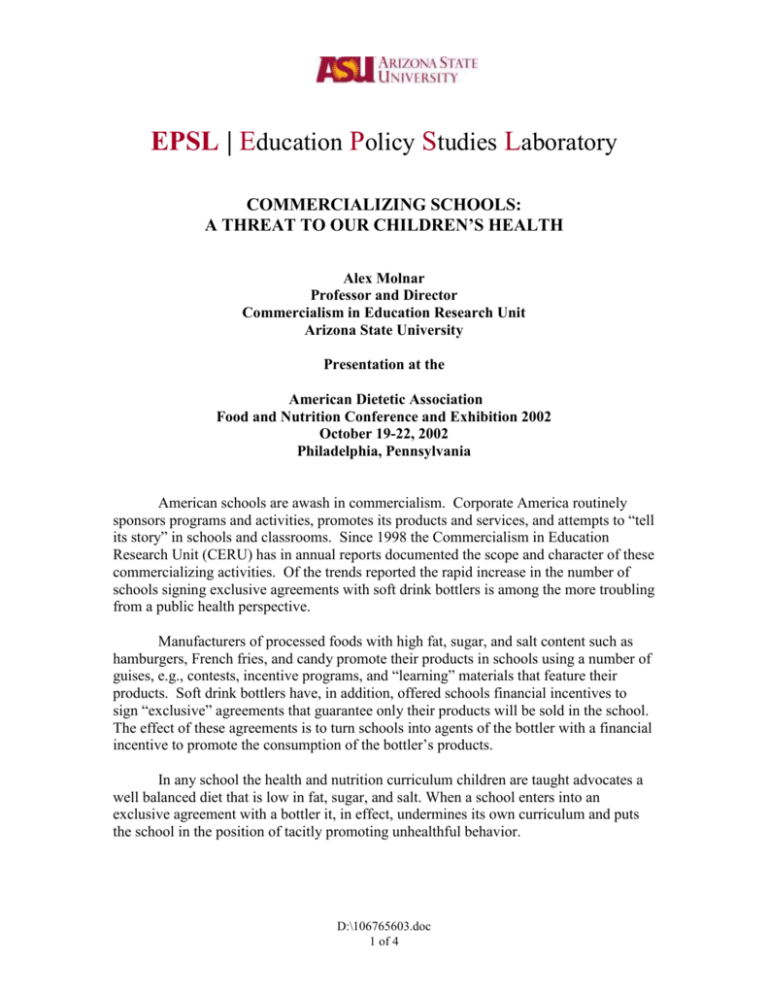
EPSL | Education Policy Studies Laboratory COMMERCIALIZING SCHOOLS: A THREAT TO OUR CHILDREN’S HEALTH Alex Molnar Professor and Director Commercialism in Education Research Unit Arizona State University Presentation at the American Dietetic Association Food and Nutrition Conference and Exhibition 2002 October 19-22, 2002 Philadelphia, Pennsylvania American schools are awash in commercialism. Corporate America routinely sponsors programs and activities, promotes its products and services, and attempts to “tell its story” in schools and classrooms. Since 1998 the Commercialism in Education Research Unit (CERU) has in annual reports documented the scope and character of these commercializing activities. Of the trends reported the rapid increase in the number of schools signing exclusive agreements with soft drink bottlers is among the more troubling from a public health perspective. Manufacturers of processed foods with high fat, sugar, and salt content such as hamburgers, French fries, and candy promote their products in schools using a number of guises, e.g., contests, incentive programs, and “learning” materials that feature their products. Soft drink bottlers have, in addition, offered schools financial incentives to sign “exclusive” agreements that guarantee only their products will be sold in the school. The effect of these agreements is to turn schools into agents of the bottler with a financial incentive to promote the consumption of the bottler’s products. In any school the health and nutrition curriculum children are taught advocates a well balanced diet that is low in fat, sugar, and salt. When a school enters into an exclusive agreement with a bottler it, in effect, undermines its own curriculum and puts the school in the position of tacitly promoting unhealthful behavior. D:\106765603.doc 1 of 4 Soft drink consumption has increased dramatically over the last decade. Since soft drink consumption is closely associated with childhood obesity, and is a risk factor for diabetes, enlightened child-oriented policy would remove soft drinks from schools altogether instead of seeking to profit from their consumption. There are signs of a backlash. In California, for example, legislators weighed a bill that would tax soft-drink syrup and use the proceeds to fund anti-obesity programs for children, while the Public Health Institute of Berkeley released a report charging that companies had too much selling and marketing power in schools.1 Some schools began curtailing such agreements on their own. In the Wisconsin school district of Mequon-Thiensville, a school board member’s resistance to an exclusivity agreement with Pepsi-Cola was met part way with an agreement between the district and the company not to allow Pepsi logos on athletic scoreboards.2 In August 2001, Madison, Wis., schools opted not to renew a contract with Coca-Cola worth $300,000 to the district.3 In late August 2002, the Los Angeles School Board banned the sale of soft drinks in the district’s 677 schools in vending machines or school stores during school hours beginning in 2004.4 In doing so, school officials noted that the action would cost schools tens of thousands of dollars each in profits received under exclusive merchandising agreements, but held firm. The ban “was inspired, in part, by recent reports spotlighting the obesity epidemic in Los Angeles, including a UCLA survey that found that 40 percent of 900 students in 14 Los Angeles Unified schools were obese,” the Los Angeles Times noted.5 Still, exclusive deals continued to hold sway. While Coca-Cola in March 2001 announced it was backing away from exclusive pouring rights contracts with schools and would not block more healthful competing drinks such as juices and water from its school vending machines, the soft drink manufacturer continued to look for ways to exercise market leverage with youth outside schoolhouse walls. In Oakland, Calif., for example, the company promised the city $500,000 for community youth programs in return for a 10-year agreement banning the sale of competitors’ soft drinks on city property.6 1 Seaton, D. (2002, April 4) School soda pacts viewed. The Press-Enterprise (Riverside, CA), p. B1. Rummler, G. (2001, Sept. 24) Ads in Milwaukee Schools Raise Money, Ire. Milwaukee Journal-Sentinel. 3 Ibid. 4 Hayasaki, E. (2002, Aug. 28) Schools to end soda sales. Los Angeles Times Part 2, p. 1. 5 Ibid. 6 Homsey, G. The market rules: when are corporate sponsorships too much of a good thing? Planning (the American Planning Assn.), Nov. 1, 2001, Vol. 67, No. 11, p. 10 2 D:\106765603.doc 2 of 4 Commercialism in Education Research Unit Commercialism in Education Publications Available On the Web at http://school commercialism.org Annual Reports on Trends in Schoolhouse Commercialism Alex Molnar. What’s in a Name? The Corporate Branding of America’s Schools – The Fifth Annual Report on Trends in Schoolhouse Commercialism. September 2002 (Tempe: Commercialism in Education Research Unit) Available: http://www.asu.edu/educ/epsl/CERU/Annual reports/EPSL-0209-103-CERU.rtf Alex Molnar. Buy Me! Buy Me! – The Fourth Annual Report on Trends in Schoolhosue Commercialism. October 2001 (Tempe: Commercialism in Education Research Unit) Available: http://www.asu.edu/educ/epsl/CERU/Annual reports/CERU 2001101/ceru-0109-101.doc Alex Molnar. Commercialism@School.com - The Third Annual Report On Trends In Schoolhouse Commercialism. September 2000 (Tempe: Commercialism in Education Research Unit) Available: http://www.asu.edu/educ/epsl/CERU/Annual reports/cace00-02.doc Alex Molnar. Cashing in on Kids - The Second Annual Report On Trends In Schoolhouse Commercialism. August 1999 (Tempe: Commercialism in Education Research Unit) Available: http://www.asu.edu/educ/epsl/CERU/Annual reports/cace-99-21.doc Alex Molnar. Sponsored Schools and Commercialized Classrooms - The First Annual Report On Trends In Schoolhouse Commercialism. August 1998 (Tempe: Commercialism in Education Research Unit) Available: http://www.asu.edu/educ/epsl/CERU/Annual%20reports/cace-98-01.doc Other Reports and Articles Alex Molnar. Corporate Involvement In Schools: Time For a More Critical Look. Winter 2001 (Tempe: Commercialism in Education Research Unit) Available: http://www.asu.edu/educ/epsl/CERU/Documents/cace-01-01.html Alex Molnar. Looking For Funds in All The Wrong Places. November 2000 (Tempe: Commercialism in Education Research Unit) Available: http://www.asu.edu/educ/epsl/CERU/Documents/cace-00-04.htm D:\106765603.doc 3 of 4 Alex Molnar. ZapMe! Linking Schoolhouse and Marketplace in a Seamless Web. April 2000 (Tempe: Commercialism in Education Research Unit) Available: http://www.asu.edu/educ/epsl/CERU/Documents/zpme.pdf Alex Molnar. Colonizing Our Future: The Commercial Transformation of America’s Schools. March 2000 (Tempe: Commercialism in Education Research Unit) Available: http://www.asu.edu/educ/epsl/CERU/Documents/cace-00-01.htm Alex Molnar. Integrating the Schoolhouse and the Marketplace: A Preliminary Assessment of the Emerging Role of Electronic Technology. April 1999 (Tempe: Commercialism in Education Research Unit) Available: http://www.asu.edu/educ/epsl/CERU/Documents/aerazapme.html Alex Molnar, Max B. Sawicky. The Hidden Costs of Channel One: Estimates for the 50 States. April 1998 (Tempe: Commercialism in Education Research Unit) Available: http://www.asu.edu/educ/epsl/CERU/Documents/cace-98-02/CACE-98-02.htm D:\106765603.doc 4 of 4
